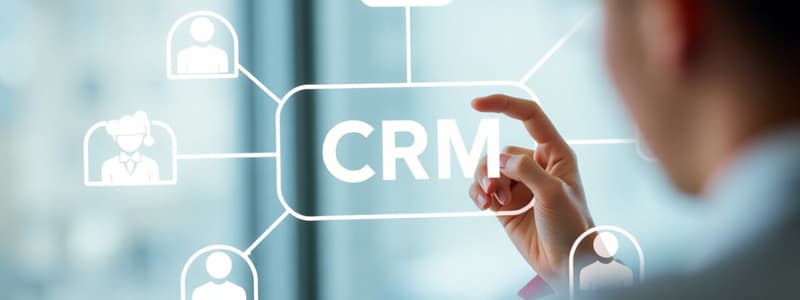Podcast
Questions and Answers
Which of the following best describes the primary goal of implementing a CRM system?
Which of the following best describes the primary goal of implementing a CRM system?
- Ensuring compliance with data protection regulations.
- Minimizing operational costs across all departments.
- Improving customer relationships, enhancing satisfaction, and driving sales growth. (correct)
- Automating internal communication processes within the company.
A company wants to ensure all its departments are using the same customer information. Which CRM function would be most helpful?
A company wants to ensure all its departments are using the same customer information. Which CRM function would be most helpful?
- Centralizing Customer Data (correct)
- Customer Segmentation
- Lead Management
- Automation of Tasks
How does CRM technology primarily assist in lead management?
How does CRM technology primarily assist in lead management?
- By tracking potential customers throughout the sales funnel. (correct)
- By generating automated reports on employee performance.
- By automating the creation of marketing materials.
- By providing direct access to customer financial records.
A business aims to improve its customer retention rate. Which CRM capability would be most directly beneficial?
A business aims to improve its customer retention rate. Which CRM capability would be most directly beneficial?
What is the main benefit of using CRM for the automation of tasks?
What is the main benefit of using CRM for the automation of tasks?
A marketing team wants to tailor its messages to different groups of customers. Which CRM function would directly support this goal?
A marketing team wants to tailor its messages to different groups of customers. Which CRM function would directly support this goal?
Which of the following is an example of viewing CRM as a strategy rather than just a technology or process?
Which of the following is an example of viewing CRM as a strategy rather than just a technology or process?
A company notices a decline in customer satisfaction scores. How can CRM's analytics and reporting function help address this issue?
A company notices a decline in customer satisfaction scores. How can CRM's analytics and reporting function help address this issue?
A company wants to improve communication and collaboration between its sales, marketing, and customer support teams. Which type of CRM system would be most suitable?
A company wants to improve communication and collaboration between its sales, marketing, and customer support teams. Which type of CRM system would be most suitable?
Which benefit of CRM is most directly associated with the ability to identify customers who are likely to discontinue using a company's services?
Which benefit of CRM is most directly associated with the ability to identify customers who are likely to discontinue using a company's services?
A marketing manager aims to optimize advertising spending by targeting customer segments with tailored campaigns. Which CRM function would be most helpful?
A marketing manager aims to optimize advertising spending by targeting customer segments with tailored campaigns. Which CRM function would be most helpful?
A business seeks to shorten its sales cycle and improve conversion rates. Which CRM capability would be most effective?
A business seeks to shorten its sales cycle and improve conversion rates. Which CRM capability would be most effective?
In a B2B context, which CRM function is most useful for managing complex sales processes involving multiple decision-makers at the client's organization?
In a B2B context, which CRM function is most useful for managing complex sales processes involving multiple decision-makers at the client's organization?
A retail company wants to provide a seamless and personalized shopping experience for its customers across all channels (online, in-store, mobile app). Which CRM benefit is MOST directly applicable?
A retail company wants to provide a seamless and personalized shopping experience for its customers across all channels (online, in-store, mobile app). Which CRM benefit is MOST directly applicable?
A software company uses a CRM system to track customer interactions, manage follow-ups, and monitor sales pipelines for its enterprise clients. Which type of organizational structure does this scenario exemplify?
A software company uses a CRM system to track customer interactions, manage follow-ups, and monitor sales pipelines for its enterprise clients. Which type of organizational structure does this scenario exemplify?
A company notices a decline in customer satisfaction scores and wants to proactively address the issue. How can CRM data be used to identify the root cause?
A company notices a decline in customer satisfaction scores and wants to proactively address the issue. How can CRM data be used to identify the root cause?
How does CRM contribute to converting satisfied customers into brand ambassadors?
How does CRM contribute to converting satisfied customers into brand ambassadors?
What is the primary goal of retention campaigns managed through a CRM system?
What is the primary goal of retention campaigns managed through a CRM system?
What benefit do automated campaign capabilities within a CRM provide to a business's marketing efforts?
What benefit do automated campaign capabilities within a CRM provide to a business's marketing efforts?
How do personalized emails enhance customer engagement?
How do personalized emails enhance customer engagement?
A coffee shop is implementing a CRM system. Which of the following actions would be most aligned with a loyalty campaign?
A coffee shop is implementing a CRM system. Which of the following actions would be most aligned with a loyalty campaign?
A telecom company uses CRM to send regular updates about data plans and exclusive offers to subscribers. This is an example of which type of campaign?
A telecom company uses CRM to send regular updates about data plans and exclusive offers to subscribers. This is an example of which type of campaign?
A streaming service utilizes user watch history to recommend TV shows or movies. What CRM personalization benefit does this exemplify?
A streaming service utilizes user watch history to recommend TV shows or movies. What CRM personalization benefit does this exemplify?
An airline uses CRM to automatically send flight check-in reminders and post-trip surveys to passengers. Which aspect of CRM capabilities does this best illustrate?
An airline uses CRM to automatically send flight check-in reminders and post-trip surveys to passengers. Which aspect of CRM capabilities does this best illustrate?
Which of the following scenarios exemplifies how a B2C company leverages CRM to personalize customer experiences?
Which of the following scenarios exemplifies how a B2C company leverages CRM to personalize customer experiences?
A national charity wants to improve its donor engagement. How could a CRM system specifically support this goal?
A national charity wants to improve its donor engagement. How could a CRM system specifically support this goal?
In what way does a CRM system act as a 'single source of truth' for customer data within an organization?
In what way does a CRM system act as a 'single source of truth' for customer data within an organization?
Which of the following is NOT a typical criterion used for customer segmentation within a CRM system?
Which of the following is NOT a typical criterion used for customer segmentation within a CRM system?
A marketing manager intends to launch a targeted campaign to re-engage inactive customers. How can CRM data assist in this initiative?
A marketing manager intends to launch a targeted campaign to re-engage inactive customers. How can CRM data assist in this initiative?
An online retailer wants to improve customer retention. How could they use CRM to achieve this?
An online retailer wants to improve customer retention. How could they use CRM to achieve this?
Which of the following illustrates how a CRM system supports converting leads into customers (the 'Purchase' stage)?
Which of the following illustrates how a CRM system supports converting leads into customers (the 'Purchase' stage)?
What is the primary goal of using a CRM system to track customers' lifecycle stages?
What is the primary goal of using a CRM system to track customers' lifecycle stages?
Flashcards
CRM (Customer Relationship Management)
CRM (Customer Relationship Management)
Strategies, processes, and technologies businesses use to manage customer interactions to improve relationships and drive sales growth.
CRM as a Technology
CRM as a Technology
CRM uses technology to collect, organize, and analyze customer data. Popular platforms include Salesforce, HubSpot, and Zoho CRM.
CRM as a Strategy
CRM as a Strategy
A business philosophy that prioritizes the customer at the center of business processes and decisions.
CRM as a Process
CRM as a Process
Signup and view all the flashcards
Centralizing Customer Data
Centralizing Customer Data
Signup and view all the flashcards
Automation of Tasks (in CRM)
Automation of Tasks (in CRM)
Signup and view all the flashcards
Customer Segmentation
Customer Segmentation
Signup and view all the flashcards
Lead Management
Lead Management
Signup and view all the flashcards
Operational CRM
Operational CRM
Signup and view all the flashcards
Analytical CRM
Analytical CRM
Signup and view all the flashcards
Collaborative CRM
Collaborative CRM
Signup and view all the flashcards
Enhanced Customer Experience
Enhanced Customer Experience
Signup and view all the flashcards
Improved Sales Performance
Improved Sales Performance
Signup and view all the flashcards
Better Marketing ROI
Better Marketing ROI
Signup and view all the flashcards
Increased Customer Retention
Increased Customer Retention
Signup and view all the flashcards
CRM in B2B
CRM in B2B
Signup and view all the flashcards
B2C (Business-to-Consumer)
B2C (Business-to-Consumer)
Signup and view all the flashcards
NfP (Not-for-Profit) CRM
NfP (Not-for-Profit) CRM
Signup and view all the flashcards
Centralized Customer Data
Centralized Customer Data
Signup and view all the flashcards
Ease of Access (CRM)
Ease of Access (CRM)
Signup and view all the flashcards
Demographic Segmentation
Demographic Segmentation
Signup and view all the flashcards
Behavioral Segmentation
Behavioral Segmentation
Signup and view all the flashcards
Customer Lifecycle Stages
Customer Lifecycle Stages
Signup and view all the flashcards
Discount and Loyalty Campaigns
Discount and Loyalty Campaigns
Signup and view all the flashcards
Retention Campaigns
Retention Campaigns
Signup and view all the flashcards
Loyalty Campaigns
Loyalty Campaigns
Signup and view all the flashcards
Personalization Capabilities
Personalization Capabilities
Signup and view all the flashcards
Benefits of Personalization
Benefits of Personalization
Signup and view all the flashcards
Automated Campaign Capabilities
Automated Campaign Capabilities
Signup and view all the flashcards
Benefits of Automated Campaigns
Benefits of Automated Campaigns
Signup and view all the flashcards
Brand Ambassadors
Brand Ambassadors
Signup and view all the flashcards
Study Notes
- CRM stands for Customer Relationship Management.
- CRM includes strategies, processes and technologies for managing interactions with current and potential customers.
- The goal of CRM is to improve customer relationships, enhance customer satisfaction, and drive sales growth by providing better service and understanding customer needs.
Core Components of CRM
- CRM as a Technology refers to the software tools that help businesses collect, organize, and analyze customer data using platforms like Salesforce, HubSpot, Zoho CRM, and Microsoft Dynamics 365.
- CRM as a Strategy is a business philosophy centered around placing the customer at the core of business processes and decision-making.
- CRM as a Process refers to a systematic approach to managing customer relationships, including lead generation and nurturing as well as customer support and satisfaction plus retention and loyalty programs.
Key Functions of CRM
- Centralizing Customer Data combines customer information from various touchpoints into a single system so that all departments have access to this central and consistent repository.
- Automation of Tasks streamlines repetitive tasks like follow-up emails and scheduling calls, which increases efficiency and frees up time.
- Customer Segmentation groups customers based on demographics, purchase behavior, helping tailor marketing messages and offers.
- Lead Management tracks potential customers throughout the sales funnel, ensuring timely follow-ups to maximize conversions.
- Improved Customer Support tracks customer interactions to provide personalized support and enable faster issue resolution by accessing customer history.
- Analytics and Reporting tracks KPIs, such as sales growth and customer retention rates as well as provides insights into customer behaviors and campaign performance.
Types of CRM
- Operational CRM focuses on streamlining and automating business processes such as sales, marketing, and service, for instance, automating email campaigns or lead assignment.
- Analytical CRM focuses on analyzing customer data to make informed decisions, like identifying high-value customers through purchase trends.
- Collaborative CRM focuses on improving communication between different departments and customers for example, sharing customer feedback across sales, marketing, and support teams.
Benefits of CRM
- Enhanced Customer Experience is when interactions are personalized using data to resolve issues faster with a complete history of interactions at employees fingertips.
- Improved Sales Performance is from tracking leads through the sales funnel and automating repetitive tasks to focus on closing deals.
- Better Marketing ROI is achieved by targeting the right audience and measuring campaign effectiveness
- Increased Customer Retention is from identifying at-risk customers, implementing retention strategies, and engaging customers with loyalty programs.
- Efficient Team Collaboration includes centralizing data so there is seamless communication between departments and aligning marketing, sales, and service teams for a unified customer experience.
- Technology plays a crucial role in fostering and maintaining customer relationships by streamlining data management, personalizing customer experiences, and automating engagement.
CRM Technology Usage Within Organizational Types
- B2B (Business-to-Business) CRM enables businesses to manage long sales cycles, nurture leads, and track interactions with multiple stakeholders, or a software company using Salesforce to monitor interactions with enterprise clients, manage follow-ups, and track sales pipeline.
- B2C (Business-to-Consumer) CRM focuses on high-volume, shorter sales cycles and personalizing customer experiences, or an e-commerce company using HubSpot to manage customer purchase history, recommend products, and track abandoned carts.
- NfP (Not-for-Profit) CRM helps organizations manage donor relationships, track donations, and run engagement campaigns, or a nonprofit that uses Zoho CRM to track volunteer registrations, organize fundraising events, communicate with donors.
Role of CRM Technology in Centralizing Customer Data
- Centralized Source is when CRM systems serve as a single source of truth for customer data, consolidating contact details, interaction history, purchase history, support tickets, and feedback/ preferences.
- Ease of Access is when teams across departments (sales, marketing, customer service) have access to real-time data to ensure consistent communications and better customer experiences.
- An example of this is when a retail brand uses a CRM to track customer preferences, enabling its marketing team to send personalized offers and its support team to address complaints effectively.
Customer Segmentation
- CRM tools allow organizations to segment customers based on demographics (age, gender, income level), behavior (purchase frequency, product preferences), psychographics (lifestyle, interests, values), and engagement (active vs. inactive customers).
- Benefits of Segmentation include enabling targeted campaigns for different audiences and groups, helping to prioritize high-value customers, and also increasing the relevance of marketing efforts.
- An example is that a gym uses Customer Relationship Management to segment members, based on gym habits, in order to tailor membership promotions
Targeting Customers at Different Lifecycle Stages
- Lifecycle Stages include awareness (introducing prospects to the brand), consideration (engaging and educating leads), purchase (converting leads into customers), retention (encouraging repeat purchases), and advocacy (turning satisfied customers into brand ambassadors).
- CRM helps by tracking where the customers are in the lifecycle, automating messaging and offers, and providing insights into customer behaviors to optimize engagement strategies.
- For example an online fashion retailer uses CRM to send discount codes to new customers (purchase stage) and loyalty rewards to frequent buyers (retention stage).
Creation of Retention and Loyalty Campaigns
- Retention Campaign consist of regular communication with existing customers to maintain engagement and satisfaction with tools like email newsletters, SMS updates, personalized offers, and exclusive offers to retain subscribers.
- Loyalty Campaigns create reward programs to encourage repeat purchases; tools include point systems, tiered rewards, and special discounts like offers after a certain number of purchases and satisfying customers into becoming brand ambassadors.
- Customer relationship Management helps the user to track the customer's lifecycle, and provides insights into customer behavior to optimize engagement strategies to send automated messaging and offer.
Personalization Capabilities and Their Benefits
- Capabilities that CRM can offer include personalized emails with customer names, past data, tailored product recommendations, dynamic website content, and predictive analytics.
- Benefits of CRM includes improved customer satisfaction, stronger emotional connections with the brand, and boosts conversion rates and ROI.
- For example, a streaming service uses CRM to recommend TV shows or movies based on a user's watch history.
Automated Campaign Capabilities and Their Benefits
- Capabilities include automation of email marketing with triggered drip campaigns, text reminders that notify about renewal and other upcoming appointments and the ability to schedule social media posting all in one tool.
- Key benefits are that time is saved plus manual effort is minimized, and it is easier to ensure consistent communication with customers along with improving scalability of marketing efforts.
- An airline could use CRM to automatically remind passengers to check-in and send post-trip surveys.
Studying That Suits You
Use AI to generate personalized quizzes and flashcards to suit your learning preferences.




